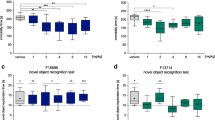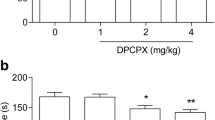Abstract
Rationale
Recent studies have reported antidepressant-like activities of the dopamine D2/D3 agonist pramipexole in the chronic mild stress model and in the forced swim test, suggesting that D3 receptor agonists may represent a new class of antidepressant drugs. However, the relative contribution of D2 or D3 receptors to the activity of pramipexole in these models is unclear.
Objectives
The aim of the current studies was to explore the role of dopamine D2 and D3 receptors in the activity of pramipexole in the mouse forced swim test.
Methods
The effect of pramipexole (0.1–3.2 mg/kg) in the mouse forced swim test was examined both in conjunction with D2 and D3 receptor antagonists (haloperidol (0.1–1 mg/kg) and LU-201640 (A-437203, 5.6–17.8 mg/kg), as well as in D3 receptor knockout mice obtained on two different background strains (C57BL/6J and B6129SF2/J). Locomotor activity was also assessed following pramipexole administration.
Results
Pramipexole produced dose-dependent reductions in immobility in the forced swim test at doses that did not produce generalized increases in locomotor activity. LU-201640, the D3 selective antagonist, failed to block the antidepressant-like effects of pramipexole. In contrast, the efficacy of pramipexole in the forced swim test was completely blocked by the D2 antagonist, haloperidol. No baseline differences were observed between knockout and wild-type mice from either background strain in locomotor activity or in the forced swim test. Furthermore, in both background strains, pramipexole showed similar efficacy in the forced swim test for both wild-type and knockout mice.
Conclusions
Taken together, these studies suggest that the D2 receptor rather than the D3 receptor is important for the antidepressant-like activity observed for pramipexole in the mouse forced swim test.




Similar content being viewed by others
References
Accili D, Fishburn CS, Drago J, Steiner H, Lachowicz JE, Park BH, Gauda EB, Lee EJ, Cool MH, Sibley DR, Gerfen CR, Westphal H, Fuchs S (1996) A targeted mutation of the D3 dopamine receptor gene is associated with hyperactivity in mice. Proc Natl Acad Sci USA 93:1945–1949
Borsini F, Pulvirenti L, Samanin R (1985) Evidence of dopamine involvement in the effect of repeated treatment with various antidepressants in the behavioural ‘despair’ test in rats. Eur J Pharmacol 110:253–256
Boulay D, Depoortere R, Rostene W, Perrault G, Sanger DJ (1999) Dopamine D3 receptor agonists produce similar decreases in body temperature and locomotor activity in D3 knockout and wild-type mice. Neuropharmacology 38:555–565
Brown AS, Gershon S (1993) Dopamine and depression. J Neural Transm 91:75–109
Corrigan MH, Denahan AQ, Wright E, Ragual RJ, Evans DL (2000) Comparison of pramipexole, fluoxetine, and placebo in patients with major depression. Depression Anxiety 11:58–65
D’Aquila PS, Collu M, Gessa GL, Serra G (2000) The role of dopamine in the mechanism of action of antidepressant drugs. Eur J Pharmacol 405:365–373
Debattista C, Solvason HB, Breen JA, Schatzberg AF (2000) Pramipexole augmentation of a selective serotonin reuptake inhibitor in the treatment of depression. J Clin Psychopharmacol 20:274–275
Drescher KU, Garcia-Ladona FJ, Teschendorf HJ, Traut M, Unger L, Wicke KM, Weddige FK, Freeman AS, Gross G (2002) In vivo effects of the selective dopamine D3 receptor antagonist A-437203. Program no. 894.6. Abstract viewer/itinerary planner. Society for Neuroscience, Washington, D.C. Online
Emilien G, Maloteaux J-M, Geurts M, Hoogenberg K, Cragg S (1999) Dopamine receptors—physiological understanding to therapeutic intervention potential. Pharmacol Ther 84:133–156
Fibiger HC (1995) Neurobiology of depression: focus on dopamine. Adv Biochem Psychopharmacol 49:1–17
Goldberg JF, Frye MA, Dunn RT (1999) Pramipexole in refractory bipolar depression. Am J Psychiatry 156:798–801
Inoue T, Tsuchiya K, Kiura J, Sakakibara S, Denda K, Kasahara T, Koyama T (1996) Bromocriptine treatment of tricyclics and heterocyclic antidepressant resistant depression. Biol Psychiatry 40:151–153
Izumi T, Inoue T, Kitagawa N, Nishi N, Shimanaka S, Takahashi Y, Kusumi I, Odagaki Y, Denda K, Ohmori T, Koyama T (2000) Open pergolide treatment of tricyclic and heterocyclic antidepressant-resistant depression. J Affect Disord 61:127–132
Joca SRL, Skalisz LL, Beijamini V, Vital M, Andreatini R (2000) The antidepressive-like effect of oxcarbazepine: possible role of dopaminergic neurotransmission. Eur Neuropsychopharmacol 10:223–228
Klimek V, Maj J (1989) Repeated administration of antidepressants enhances agonist affinity for mesolimbic D3-receptors. J Pharm Pharmacol 41:555–558
Lagos P, Scorza C, Monti JM, Jantos H, Reyes-Parada M, Silveira R, Ponzoni A (1998) Effects of the D3 preferring dopamine agonist pramipexole on sleep and waking, locomotor activity and striatal dopamine release in rats. Eur Neuropsychopharmacol 8:113–120
Lammers CH, Diaz J, Schwartz, Sokoloff P (2000) Selective increase of dopamine D3 receptor gene expression as a common effect of chronic antidepressant treatments. Mol Psychiatry 5:378–388
Lattanzi L, Dell’Osso L, Cassano P, Pini S, Rucci P, Houck PR, Gemignani A, Battistini G, Bassi A, Abelli M, Cassano GB (2002) Pramipexole in treatment-resistant depression: a 16 week naturalistic study. Bipolar Disorders 4:307–314
Levant B (1997) The D3 dopamine receptor: neurobiology and potential clinical relevance. Pharmacol Rev 49:231–252
Levesque D, Diaz J, Pilon C, Martres MP, Giros B, Souil E, Schott D, Morgat JL, Schwartz JC, Sokoloff P (1992) Identification, characterization, and localization of the dopamine D3 receptor in rat brain using 7-[3H]hydroxy-N,N-di-n-propyl-2-aminotetralin. Proc Natl Acad Sci USA 89:8155–8159
Maj J, Rogoz Z (1999) Synergistic effect of pramipexole and sertraline in the forced swim test. Pol J Pharmacol 51:471–475
Maj J, Rogoz Z, Skuza G, Kolodziejczyk K (1997a) Antidepressant effects of pramipexole, a novel dopamine receptor agonist. J Neural Transm 104:525–533
Maj J, Rogoz Z, Skuza G, Kolodziejczyk K (1997b) The behavioral effects of pramipexole, a novel dopamine receptor agonist. Eur J Pharmacol 324:31–37
Maj J, Dziedzicka-Wasylewska M, Rogoz R, Rogoz Z (1998) Effect of antidepressant drugs administered repeatedly on the dopamine D3 receptors in the rat brain. Eur J Pharmacol 351:31–37
Mierau J, Schingnitz G (1992) Biochemical and pharmacological studies on pramipexole, a potent and selective dopamine D2-receptor agonist. Eur J Pharmacol 215:161–170
Mierau J, Schneider FJ, Ensinger HA, Chio CL, Lajiness ME, Huff RM (1995) Pramipexole binding and activation of cloned and expressed dopamine D2, D3 and D4 receptors. Eur J Pharmacol 290:29–36
Muscat R, Papp M, Willner P (1992) Antidepressant-like effects of dopamine agonists in an animal model of depression. Biol Psychiatry 31:937–946
Nakazawa T, Yasuda T, Ueda J, Ohsawa K (2003) Antidepressant-like effects of apigenin and 2,4,5-trimethoxycinnamic acid in the forced swimming test. Biol Pharmacol Bull 26:474–480
Perachon S, Schwartz J-C, Sokoloff P (1999) Functional potencies of new antiparkinsonian drugs at recombinant human dopamine D1, D2 and D3 receptors. Eur J Pharmacol 388:293–300
Plaznik A, Kostowski W (1987) The effects of antidepressants and electroconvulsive shocks on the functioning of the mesolimbic dopaminergic system: a behavioral study. Eur J Pharmacol 135:389–396
Porsolt RD Anton G, Blavet N, Jalfre M (1978) Behavioural despair in rats: a new model sensitive to antidepressant treatments. Eur J Pharmacol 47:379–391
Ramirez AD, Wong S, Menniti FS (2003a) Pramipexole inhibits MPTP toxicity in mice by dopamine D3 dependent and independent mechanisms. Eur J Pharmacol 475:29–35
Ramirez AD, Menniti FS, Wong S, Shrikhande A (2003b) Inactivation of dopamine receptors by EEDQ in vivo: selective protection by D2/D3 compounds. Program no. 409.2. 2003 Abstract viewer/itinerary planner. Society for Neuroscience, Washington, DC. Online
Sautel F, Griffon N, Levesque D, Pilon C, Schwartz J-C (1995) A functional test identifies dopamine agonists selective for D3 versus D2 receptors. Neuroreport 6:329–332
Serra G, Collu M, D’Aquila PS, De Montis GM, Gessa GL (1990) Possible role of dopamine D1 receptor in the behavioural supersensitivity to dopamine agonists induced by chronic treatment with antidepressants. Brain Res 527:234–243
Sokoloff P, Giros B, Martres MP, Bouthenet ML, Schwartz JC (1990) Molecular cloning and characterization of a novel dopamine receptor (D3) as a target for neuroleptics. Nature 347:146–151
Sporn J, Ghaemi SN, Sambur MR, Rankin MA, Recht J, Sachs GS, Rosenbaum JF, Fava M (2000) Pramipexole augmentation in the treatment of unipolar and bipolar depression: a retrospective chart review. Ann Clin Psychiatry 12:137–140
Svensson K, Carlsson A, Huff RM, Kling-Petersen T, Waters N (1994) Behavioral and neurochemical data suggest functional differences between dopamine D2 and D3 receptors. Eur J Pharmacol 263:235–243
Theohar C, Fischer-Cornelssen K, Brosch H, Fischer EK, Petrovic D (1982) A comparative, multicenter trial between bromocriptine and amitriptyline in the treatment of endogenous depression. Arzneimittelforschung 32:783–787
Unger L, Garcia-Ladona F, Wernet W, Sokoloff P, Gross G (2002) In vitro characterization of the selective dopamine D3 receptor antagonist A-437203. Program no. 894.5. Abstract viewer/itinerary planner. Society for Neuroscience, Washington, DC. Online
Wada T, Kanno M, Aoshima T, Otani K (2001) Dose-dependent augmentation effect of bromocriptine in a case with refractory depression. Prog Neuropsychopharmacol 25:457–462
Waehrens J, Gerlach J (1981) Bromocriptine and imipramine in endogenous depression. A double-blind controlled trial in out-patients. J Affect Disord 3:193–202
Weiner I, Schiller D, Gaisler-Salomon I, Green A, Joel D (2003) A comparison of drug effects in latent inhibition and the forced swim test differentiates between the typical antipsychotic haloperidol, the atypical antipsychotics clozapine and olanzapine, and the antidepressants imipramine and paroxetine. Behav Pharmacol 14:215–222
Willner P (1983a) Dopamine and depression: a review of recent evidence. I. Empirical studies. Brain Res 287:211–224
Willner P (1983b) Dopamine and depression: a review of recent evidence. II. Theoretical approaches. Brain Res 287:225–236
Willner P (1983c) Dopamine and depression: a review of recent evidence. III. The effects of antidepressant treatments. Brain Res 287:237–246
Willner P (1997) The mesolimbic dopamine system as a target for rapid antidepressant action. Int Clin Psychopharmacol 12:S7–S14
Willner P, Lappas S, Cheeta S, Muscat R (1994) Reversal of stress-induced anhedonia by the dopamine receptor agonist, pramipexole. Psychopharmacology 115:454–462
Author information
Authors and Affiliations
Corresponding author
Rights and permissions
About this article
Cite this article
Siuciak, J.A., Fujiwara, R.A. The activity of pramipexole in the mouse forced swim test is mediated by D2 rather than D3 receptors. Psychopharmacology 175, 163–169 (2004). https://doi.org/10.1007/s00213-004-1809-7
Received:
Accepted:
Published:
Issue Date:
DOI: https://doi.org/10.1007/s00213-004-1809-7




